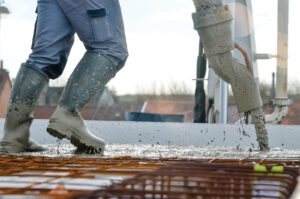1910.136(a) – Foot Protection
“At Red Wing, OSHA safety footwear standards are a driving force in everything we do. That’s why our safety program delivers superior-quality footwear that’s specified for your employees and their job sites. Our footwear has all the features, fit and comfort your workers need to feel confident and productive on the job — and even more importantly — to go home safe and sound at the end of the day.” -Tito Warren, President, Global Industrial Sales and Operations, Red Wing Shoe Company, 1-800-733-9464, redwingsafety.com
General requirements. The employer shall ensure that each affected employee uses protective footwear when working in areas where there is a danger of foot injuries due to falling or rolling objects, or objects piercing the sole, or when the use of protective footwear will protect the affected employee from an electrical hazard, such as a static-discharge or electric-shock hazard, that remains after the employer takes other necessary protective measures.

It is important to identify potential existing hazards and choose footwear that will protect against them. © Image’in – stock.adobe.com
The standard goes on to specify that protective footwear must comply with any of the following consensus standards:
- ASTM F-2412-2005, “Standard Test Methods for Foot Protection,” which requires footwear’s performance to be evaluated for impact and compression resistance in the toe area; metatarsal and puncture protection; conductive properties to reduce hazards from static electricity buildup; electrical hazards from stepping on a live wire; and static dissipative properties.
- ASTM F-2413-2005, “Standard Specification for Performance Requirements for Protective Footwear,” which are incorporated by reference in § 1910.6
- ANSI Z41-1999, “American National Standard for Personal Protection — Protective Footwear,” which is incorporated by reference in § 1910.6
- ANSI Z41-1991, “American National Standard for Personal Protection — Protective Footwear,” which is incorporated by reference in § 1910.6
Protective footwear that the employer demonstrates is at least as effective as protective footwear that is constructed in accordance with one of the above consensus standards will be deemed to be in compliance with the requirements.
Occupational foot protection is part of OSHA’s Personal Protective Equipment (PPE) standards.
The following industries were most cited by federal OSHA during the period October 2020 through September 2021:
- Manufacturing
- Retail Trade
- Transportation and Warehousing
- Construction
- Administrative and Support and Waste Management and Remediation Services
- Retail Trade
Who pays for safety footwear?
The answer to this question depends in part on whether or not the footwear in question is worn only at work. A rule issued by OSHA in 2007 said if non-specialty, safety-toe protective footwear can be worn off the workplace, employers aren’t required to pay for it. If the safety-toe protective footwear is a non-standard “specialty” item, such as nonskid shoes, the employer must pay for them. If employees are required by employers to keep non-specialty safety-toe protective footwear at the workplace, companies must pay for that footwear. If the safety-toe protective footwear is a non-standard “specialty” item, such as nonskid shoes, the employer must pay for them. OSHA also orders employers to pay for required footwear using metatarsal protection. In general, employers must provide PPE at no cost to their employees when the PPE is used to comply with OSHA standards.
When should protective footwear be worn?
Foot protection should be worn where employees are potentially exposed to corrosive or poisonous materials; electrical hazards; static electricity that could cause an explosion; heavy objects that could roll onto feet; sharp objects that could puncture the foot; molten metal that could splash onto feet; and hot or slippery surfaces. Thus, it is important to have an in-house safety manager or an outside consultant conduct a thorough assessment of facility areas and operations, in order to identify all of the existing hazards and choose footwear that will protect against them. PPE, along with engineering solutions (including elimination or substitution), safe work practices and administrative controls, is an important part of helping prevent the more than two million nonfatal workplace injuries and illnesses that occur in private industry workplaces each year, according to the U.S. Bureau of Labor Statistics (BLS). Approximately 120,000 workers annually suffer from toe, foot and ankle injuries, which average six days to heal. The most common occupational foot injuries are:
- Broken foot
- Puncture wounds
- Amputation of toes or feet
- Foot sprain
- Burns
- Cuts and lacerations
- Hypothermia
Safety shoes and boots are available in a wide variety of styles and sizes, in order to select footwear that will protect against hazards, as well as keep feet warm in cold conditions with insulation or dry in wet conditions with waterproofing. Safety footwear may be puncture-resistant and/or heat-resistant. Other features include steel, composite or soft toes and metatarsal guards. Boots made from non-conductive materials will protect the wearer from electric shock. Static dissipative boots provide some protection against electric shock, but are primarily useful when coming in contact with static electricity. In addition to being appropriate for the hazards likely to be faced by the wearer, safety footwear should be comfortable. Many manufacturers strive to develop feature-laden footwear that is nonetheless lightweight, for comfort that lasts an entire shift. WMHS
- To read the standard, visit: https://www.osha.gov/laws-regs/regulations/standardnumber/1910/1910.136



